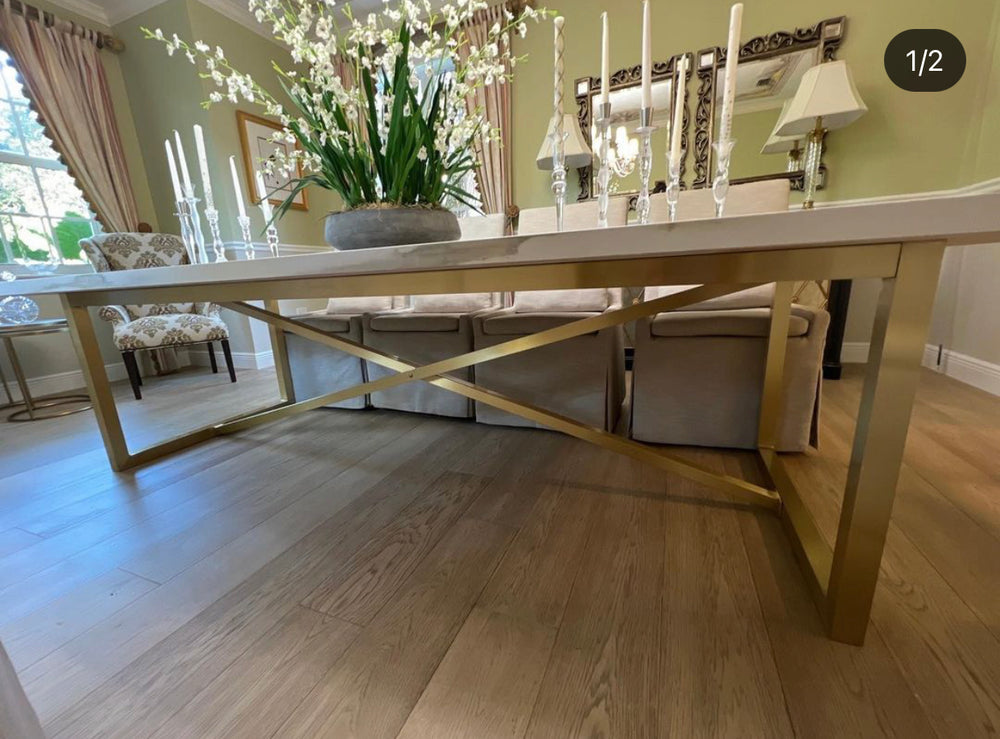Leading Fads in Dining Room Table Legs to Raise Your Eating Space
Leading Fads in Dining Room Table Legs to Raise Your Eating Space
Blog Article
A Comprehensive Check Out Table Leg Styles: Locating the Ideal Match
Choosing the right dining table leg design is vital for both visual appeal and functional performance. Typical four legs provide timeless sophistication and stability, while the stand base gives raised legroom and a modern look. For those with larger tables, trestle legs make sure sturdy support, whereas barrette legs present a mid-century modern-day ambiance with their minimal layout. The x-shaped legs blend contemporary design with improved security. Each of these alternatives brings special advantages, making the selection more than simply a matter of preference. Explore even more to discover which design completely enhances your eating space and way of life.
Standard Four Legs
Amongst the different types of dining table leg designs, the traditional four-leg style continues to be an ageless selection for numerous homes. 4 legs provide well balanced support, making sure the table stays secure and capable of bearing substantial weight (dining room table legs).
From a visual perspective, the traditional four-leg layout can be quickly adapted to various interior designs. Whether crafted from wood, steel, or a mix of materials, these legs can be delicately carved, sleek and minimalistic, or anything in between. Their versatility allows them to complement both rustic and contemporary setups flawlessly.
Moreover, the simple structure of the four-leg design assists in simplicity of activity and positioning within an area. Unlike more complicated bases, this style decreases blockages, giving ample legroom for diners. In summary, the standard four-leg dining table leg style marries sustaining style with functional functionality, making it a sharp option for those looking for both kind and function in their dining furniture.
Stand Base
Often celebrated for its elegant and space-efficient style, the pedestal base is a recognized choice to the standard four-leg arrangement in eating table leg designs. This distinct base commonly includes a solitary main column supporting the table top, which can differ in kind, from ornately carved timber to sleek, modern steel. Among the key benefits of the stand base is its capacity to make the most of legroom and seating adaptability. Without edge legs, restaurants are paid for higher freedom of movement, making it an ideal selection for round and oval tables that advertise more intimate and comprehensive gatherings.
The central column itself offers a canvas for elaborate designs and artistic expressions, including a component of aesthetic rate of interest beneath the table. In recap, the stand base integrates performance with style, making it a fine-tuned and sensible option for diverse eating settings.
Trestle Legs
Trestle legs give a durable and classic foundation for dining tables, characterized by their straight cross-bracing and tough support beam of lights. Stemming from middle ages times, this design has evolved yet retained its necessary framework, making it a seasonal favorite in both traditional and contemporary settings. The central trestle beam of light, commonly sustained by two or more upright blog posts, uses remarkable security, enabling bigger table lengths without the need for additional legs.
A substantial benefit of trestle leg tables is the sufficient legroom they offer. Unlike tables with four edge legs, the lack of blockages at the table's sides offers unobstructed space for chairs and diners, enhancing comfort and accessibility. This makes trestle tables excellent for fitting larger events, whether in a dining-room or a banquet hall.
From rustic farmhouse to sleek modern layouts, trestle legs can be personalized to fit private tastes. Their long-lasting charm and practical advantages make trestle legs an engaging option for those looking for both style and usefulness in their dining table.
Barrette Legs

The allure of barrette legs exists in their simplicity and flexibility - dining room table legs. Readily available in a variety of materials, consisting of steel and brass, they can be finished in many colors to enhance various interior styles. other Whether coupled with a rustic wooden tabletop or a contemporary glass surface area, hairpin legs easily blend performance with a touch of vintage charm
Longevity is an additional significant attribute of barrette legs. In spite of their fragile look, these legs are crafted to bear substantial weight, making certain the dining table remains secure and protected. Additionally, they are reasonably easy to set up, making them a popular selection for do it yourself lovers and expert furnishings makers alike.
X-Shaped Legs

Created from materials such as steel, wood, or a combination of both, X-shaped legs can be customized to click to investigate match numerous layout preferences. Steel legs frequently lend a sleek and industrial feel, suitable for loft-style houses and modern eating rooms.
In addition, the design behind X-shaped legs makes certain also weight distribution, reducing the danger of wobbling and enhancing resilience. This makes them especially fit for larger dining tables that need extra support. Basically, X-shaped legs blend sensible design with modern-day visual appeals, making them a classic option for diverse dining settings.
Final Thought
A detailed understanding of dining table leg designs discloses the distinctive attributes and benefits this link of each layout. Trestle legs ensure durable assistance for bigger tables, and hairpin legs present a mid-century modern aesthetic.
Report this page